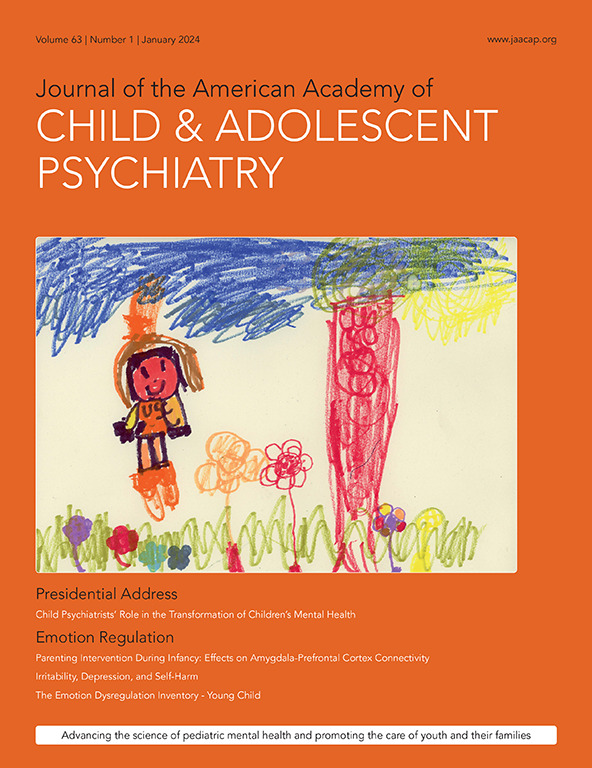Perceived Racism, Brain Development, and Internalizing and Externalizing Symptoms: Findings From the ABCD Study.
IF 9.2
1区 医学
Q1 PEDIATRICS
Journal of the American Academy of Child and Adolescent Psychiatry
Pub Date : 2025-04-10
DOI:10.1016/j.jaac.2025.04.005
引用次数: 0
Abstract
OBJECTIVE Racial discrimination drives health disparities among racial/ethnic minority youth, creating chronic stress that affects brain development and contributes to mental and behavioral health issues. This study analyzed data from the Adolescent Brain Cognitive Development (ABCD) Study to examine the neurobiological mechanisms linking discrimination to mental and behavioral health outcomes. METHOD A sample of 3,321 racial/ethnic minority youth was split into training (80%, n=2,674) and testing (20%, n=647) groups. Propensity-score-weighted machine learning was used to assess the effects of perceived discrimination on two-year changes in resting-state functional connectivity between three subcortical regions (nucleus accumbens, amygdala, hippocampus) and large-scale brain networks. Mediation analyses evaluated whether brain changes mediated sex-specific effects on internalizing or externalizing symptoms. RESULTS Perceived discrimination was significantly associated with two-year changes in connectivity of the nucleus accumbens, amygdala, and hippocampus in both cross-validation and independent testing. Key findings included decreases in nucleus accumbens connectivity with retrosplenial-temporal and sensorimotor (hand) networks, decreases in amygdala connectivity with the sensorimotor (mouth) network, and increases in hippocampal connectivity with the auditory network. These changes suggest accelerated maturation in these connections among youth reporting higher discrimination levels. Moderated mediation analyses revealed sex differences, with discrimination-related changes in nucleus accumbens connectivity linked to poorer internalizing outcomes in female participants. CONCLUSIONS The results indicate perceived racial discrimination experienced in adolescence impact subcortical-cortical brain development, which affect mental and behavioral health outcomes in a sex-specific manner.感知种族主义、大脑发育、内化和外化症状:来自ABCD研究的发现
客观:种族歧视导致种族/少数民族青年之间的健康差距,造成慢性压力,影响大脑发育,并导致心理和行为健康问题。本研究分析了青少年大脑认知发展(ABCD)研究的数据,以研究将歧视与心理和行为健康结果联系起来的神经生物学机制。方法将3321名少数民族青年样本分为训练组(80%,n= 2674)和测试组(20%,n=647)。使用倾向得分加权机器学习来评估感知歧视对三个皮层下区域(伏隔核、杏仁核、海马体)和大规模大脑网络之间静息状态功能连通性两年变化的影响。中介分析评估了脑变化是否介导了内在化或外在化症状的性别特异性影响。结果在交叉验证和独立测试中,感知歧视与隔核、杏仁核和海马的两年连通性变化显著相关。主要发现包括伏隔核与脾后颞叶和感觉运动(手)网络的连通性减少,杏仁核与感觉运动(嘴)网络的连通性减少,海马与听觉网络的连通性增加。这些变化表明,在报告受歧视程度较高的青年中,这些联系的成熟速度加快。适度的中介分析揭示了性别差异,女性参与者中与歧视相关的伏隔核连通性变化与较差的内化结果有关。结论青少年时期的种族歧视会影响大脑皮层下和皮层的发育,从而影响心理和行为健康。
本文章由计算机程序翻译,如有差异,请以英文原文为准。
求助全文
约1分钟内获得全文
求助全文
来源期刊
CiteScore
21.00
自引率
1.50%
发文量
1383
审稿时长
53 days
期刊介绍:
The Journal of the American Academy of Child & Adolescent Psychiatry (JAACAP) is dedicated to advancing the field of child and adolescent psychiatry through the publication of original research and papers of theoretical, scientific, and clinical significance. Our primary focus is on the mental health of children, adolescents, and families.
We welcome unpublished manuscripts that explore various perspectives, ranging from genetic, epidemiological, neurobiological, and psychopathological research, to cognitive, behavioral, psychodynamic, and other psychotherapeutic investigations. We also encourage submissions that delve into parent-child, interpersonal, and family research, as well as clinical and empirical studies conducted in inpatient, outpatient, consultation-liaison, and school-based settings.
In addition to publishing research, we aim to promote the well-being of children and families by featuring scholarly papers on topics such as health policy, legislation, advocacy, culture, society, and service provision in relation to mental health.
At JAACAP, we strive to foster collaboration and dialogue among researchers, clinicians, and policy-makers in order to enhance our understanding and approach to child and adolescent mental health.

 求助内容:
求助内容: 应助结果提醒方式:
应助结果提醒方式:


